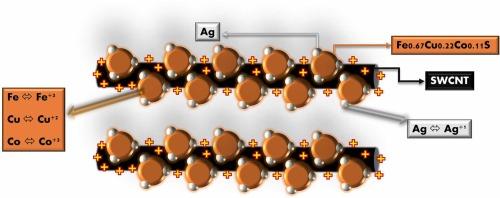Ag@Fe0.67Cu0.22Co0.11S核壳纳米结构与SWCNTs协同集成以改善超级电容器性能
IF 6.3
2区 材料科学
Q2 CHEMISTRY, PHYSICAL
引用次数: 0
摘要
过渡金属硫化物由于其增强的功率密度和循环稳定性而对超级电容器的应用至关重要。在这项研究中,我们合成了核壳纳米粒子Ag@Fe0.67Cu0.22Co0.11S,并将其与单壁碳纳米管(SWCNTs)集成以制备纳米复合材料。利用x射线衍射(XRD)、扫描电镜(SEM)、x射线能谱(EDS)和傅里叶变换红外光谱(FTIR)对材料进行了表征,确定了材料的形貌和成分。电化学测试表明,优化后的样品具有最高的比电容(1097.8 F/g)和优越的电荷转移电阻(2.965 Ω),具有优异的电化学性能。其非对称器件在4000次循环后能量密度为55.36 Wh/kg,电容保持率为82.16%。Brunauer - Emmett - Teller (BET)分析还显示,该材料具有120 m²/g的高表面积和平均孔径为8.2 nm的介孔。这些发现突出了Ag@Fe0.67Cu0.22Co0.11S-SWCNTs纳米复合材料通过改善能量密度、稳定性和性能在推进超级电容器技术方面的潜力。本文章由计算机程序翻译,如有差异,请以英文原文为准。

Synergistic integration of Ag@Fe0.67Cu0.22Co0.11S core-shell nanostructures and SWCNTs for improved supercapacitor performance
Transition metal sulfides are critical for supercapacitor applications due to their enhanced power density and cycle stability. In this study, we synthesized core-shell Ag@Fe0.67Cu0.22Co0.11S nanoparticles and integrated them with single-walled carbon nanotubes (SWCNTs) to create nanocomposites. The materials were characterized using X-ray diffraction (XRD), scanning electron microscopy (SEM), energy dispersive X-ray spectroscopy (EDS), and Fourier transform infrared (FTIR) spectroscopy to confirm their morphology and composition. Electrochemical testing revealed that the optimal sample exhibited the highest specific capacitance (1097.8 F/g) and superior charge transfer resistance (2.965 Ω), indicating excellent electrochemical performance. Its asymmetric device delivered an energy density of 55.36 Wh/kg and retained 82.16 % capacitance after 4000 cycles. The Brunauer−Emmett−Teller (BET) analysis also revealed a high surface area of 120 m²/g and mesoporosity with an average pore size of 8.2 nm. These findings highlight the potential of the Ag@Fe0.67Cu0.22Co0.11S-SWCNTs nanocomposite in advancing supercapacitor technology through improved energy density, stability, and performance.
求助全文
通过发布文献求助,成功后即可免费获取论文全文。
去求助
来源期刊

Journal of Alloys and Compounds
工程技术-材料科学:综合
CiteScore
11.10
自引率
14.50%
发文量
5146
审稿时长
67 days
期刊介绍:
The Journal of Alloys and Compounds is intended to serve as an international medium for the publication of work on solid materials comprising compounds as well as alloys. Its great strength lies in the diversity of discipline which it encompasses, drawing together results from materials science, solid-state chemistry and physics.
 求助内容:
求助内容: 应助结果提醒方式:
应助结果提醒方式:


